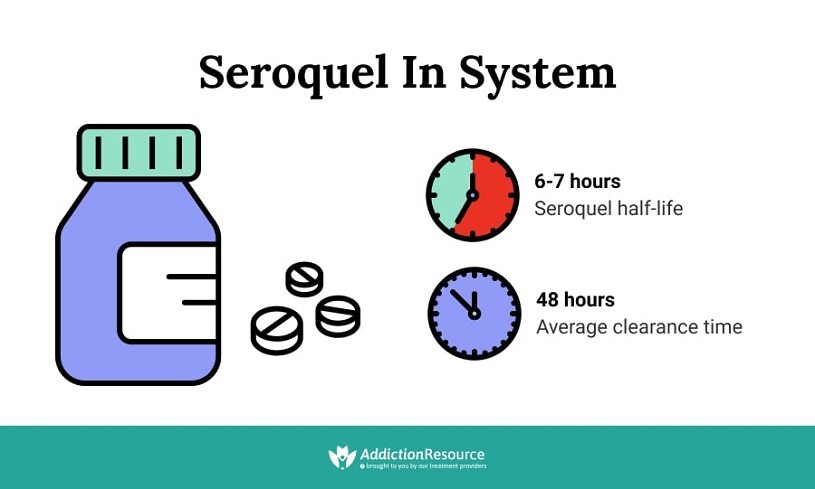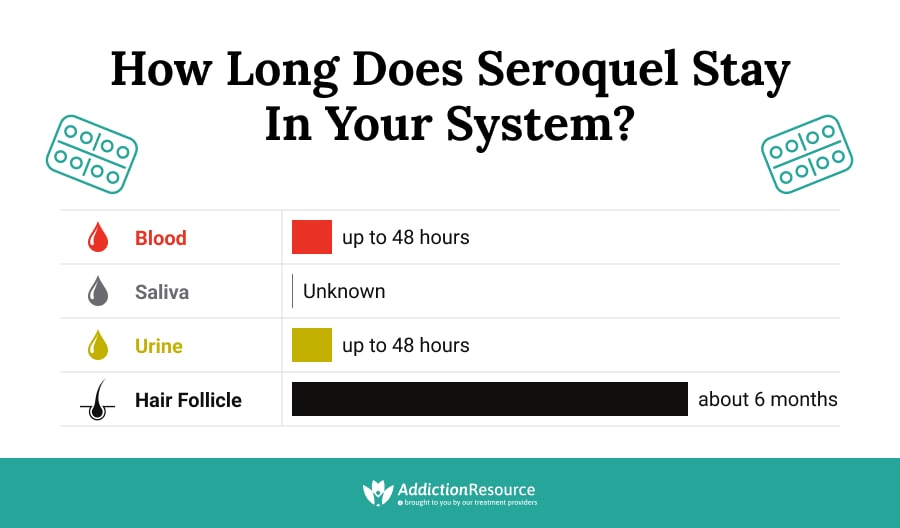Quetiapine, marketed under the brand name Seroquel, is an atypical antipsychotic drug with efficacy demonstrated in clinical trials for the treatment of schizophrenia, bipolar disorder, major depressive disorder, and generalized anxiety disorder.
Initially manufactured as an immediate-release (IR) formulation, an extended-release (XR) formulation has recently been introduced to provide more patient options. Do these two formulations metabolize differently in the body? Since Seroquel can lead to an increased risk of irregular heart rhythm, understanding its half life is crucial to avoid potentially dangerous Seroquel interactions.
Continue reading to learn about Seroquel’s benefits, how long it remains in the body, and its potential impact on drug screening tests.
Table Of Contents:
- Seroquel Overview
- How Long Does Quetiapine Stay In Your System?
- How Long Does Seroquel 25 mg Stay In Your System?
- How Long Does It Take For Seroquel To Get Out Of Your System?
- Does Seroquel Show On A Drug Test?
- How to Flush Seroquel Out of Your System?
- How Long Does It Take For Quetiapine To Get Out Of Your System? – Bottom Line
- People Also Ask

Seroquel Overview
Seroquel, also known by its generic name quetiapine, is an atypical antipsychotic medication widely used in the treatment of various psychiatric conditions, including schizophrenia, bipolar disorder, and major depressive disorder. It is also sometimes prescribed for generalized anxiety disorder.
This medication comes in two primary formulations:
- Oral tablet immediate-release (IR) for twice-daily dosing, frequently combined with injectable antipsychotics
- Oral tablet extended-release (XR) for once-daily dosing, often used as monotherapy
The pharmacokinetics of Seroquel vary between its immediate-release and extended-release formulations. The IR formulation is designed to be absorbed quickly, providing rapid relief of symptoms. In contrast, the XR formulation releases the drug more slowly, maintaining stable plasma levels over a longer period. Reducing the frequency of dosing can improve adherence.
Seroquel Mechanism of Action
Seroquel primarily modulates neurotransmitter activity in the brain, targeting serotonin (5-HT) and dopamine (D2) receptors as antagonists. This action stabilizes mood and reduces psychotic symptoms, making it effective in treating bipolar disorder and schizophrenia.
Additionally, Seroquel has an affinity for histamine H1 and adrenergic alpha-1 and alpha-2 receptors. Blocking histamine H1 receptors can cause sedation, leading to its off-label use as a sleep aid. Its effect on adrenergic receptors contributes to its calming properties and efficacy in treating anxiety.
How Long Does Quetiapine Stay In Your System?
When you take quetiapine by mouth, it’s quickly absorbed into your system, reaching its highest concentration in the blood in about 1.5 hours. Once ingested, the tablet form is 100% bioavailable. Eating food slightly increases its absorption, with peak blood levels rising by 25% and the overall absorption increasing by 15%.
Other factors appear to influence Seroquel metabolism, such as:
Age
In elderly patients (65 years and older), the body’s ability to clear quetiapine is reduced by 40% compared to younger patients. Therefore, a dosage adjustment might be necessary for older adults.
Renal Insufficiency
Patients with severe kidney impairment have a 25% lower clearance of quetiapine than those with normal kidney function. However, the drug levels in these patients still fall within the typical range, so dosage adjustment is generally not required.
Hepatic Insufficiency
Patients with liver impairment have a 30% lower clearance of quetiapine, and some may experience significantly higher drug levels. Since quetiapine is extensively processed by the liver, patients with liver issues may require dosage adjustments to avoid high plasma levels.
It appears that there is no difference in how the body processes the drug between men and women, among different racial groups, or between smokers and non-smokers.
Quetiapine Half Life
Another important factor is the medication’s half-life. It’s helpful to consider Seroquel’s half-life to better understand how long it takes for Seroquel to get out of your system.
The Seroquel half life is the time it takes for the drug’s concentration in the bloodstream to be reduced by half. This measure determines how long a drug’s effects will last, how often it needs to be administered and how long it might be detectable in the body.
Quetiapine is primarily eliminated from the body through liver metabolism, with an average half-life between 6 to 7 hours when taken at typical clinical Seroquel doses. This means that as the drug is metabolized and eliminated, its concentration in your body decreases. After about 6 hours, you may notice that the intensity of Seroquel side effects begins to lessen.

How Long Does Seroquel 25 mg Stay In Your System?
However, does this apply to all available Seroquel dosages? Quetiapine immediate-release (IR) oral tablets come in various strengths, including 25 mg, 50 mg, 100 mg, 200 mg, 300 mg, and 400 mg. The extended-release (XR) version is available in 50 mg, 150 mg, 200 mg, 300 mg, and 400 mg doses. The Seroquel 25 mg form is an immediate-release version.
Evidence suggests that both Quetiapine XR (extended-release) and Quetiapine IR (immediate-release) have a linear absorption and elimination rate, sharing the same half-life of about 7 hours. Yet, while both formulations offer similar bioavailability, they differ in how quickly they reach peak blood levels and how long they are maintained.
The IR formulation reaches peak concentration in about 2 hours, while the XR formulation takes about 5 hours to peak and maintains higher levels for longer. This allows the XR formulation to be taken less frequently, typically once daily, to keep effective drug levels in the body.
How Long Does It Take For Seroquel To Get Out Of Your System?
The complete elimination of a drug from the body can be estimated using its half-life. Typically, it takes about 4 to 5 half-lives for a drug to be eliminated from the system. The formula to calculate the time for complete elimination is:
Complete Elimination Time = Half-Life × 5
Since we already know there is no major difference between both formulation half-lives, let’s apply this formula to Seroquel:
- For the lower end (6 hours)
Complete elimination time = 6 hours × 5 = 30 hours
- For the upper end (7 hours):
Complete elimination time = 7 hours × 5 = 35 hours
Based on its elimination half-life of 7 hours, Seroquel would take approximately 35 hours to completely eliminate from your system.
Does Seroquel Show On A Drug Test?
Several drugs can lead to false-positive results in urine drug tests. This occurs because these medications can interfere with the immunoassay methods used in standard drug testing, causing them to identify venlafaxine as other substances mistakenly.
As for Seroquel, there have been reports indicating that taking Seroquel can cause false positive results in urine tests for ketamine, methadone, and tricyclic antidepressants. If you test positive for these drugs while taking Seroquel, it’s important to confirm the results using more accurate methods, like chromatographic techniques.
How Long Does Seroquel Stay In Your Urine?
According to evidence, Seroquel is generally expected to leave the system within 35 hours.
However, one study tested for Quetiapine in blood, urine, and hair samples 43 hours after administration. Although small, traces of Quetiapine were still found in both blood and urine.
How Long Does Seroquel Stay In Your Hair Follicle?
Six months after taking Seroquel, traces of its active chemicals were still detectable in hair samples.
This indicates that Seroquel can stay in hair follicles longer than in urine or blood. The final hair segment tested showed 0.011 ng/mg of quetiapine, while the other segments were negative. This low level suggests that the individual had only taken one or a few doses of quetiapine and was not a regular user.

How to Flush Seroquel Out of Your System?
When it comes to detoxing from Seroquel, it’s not advised to quit cold turkey. Stopping suddenly can lead to Quetiapine withdrawal symptoms. These symptoms can vary in intensity and duration depending on the dose, duration of use, and individual factors.
Common Seroquel withdrawal symptoms include:
- Insomnia
- Nausea and Vomiting
- Headaches
- Dizziness
- Irritability
- Anxiety
- Depression
- Restlessness
- Sweating
- Tremors
- Flu-like Symptoms
To manage these symptoms, it is crucial to taper off quetiapine gradually under the supervision of a healthcare provider. Always follow your doctor’s guidance for a better medication experience and prevent a Seroquel overdose, which can lead to overdose symptoms such as extreme drowsiness, rapid heart rate, and fainting.
How Long Does It Take For Quetiapine To Get Out Of Your System? – Bottom Line
Seroquel generally takes around 35 hours to leave the system. The immediate-release (IR) and extended-release (XR) formulations have a similar half-life of approximately 7 hours. However, the XR formulation will maintain the therapeutic effects for longer. If you are 65 years old or have a hepatic condition, your body will have a lower clearancer of quetiapine.
Remember that quetiapine can sometimes cause false positive results in urine enzyme immunoassays for methadone, ketamine and tricyclic antidepressants. If you have a drug test coming up, inform the testing administrator about your prescription to avoid potential misinterpretations of the results.
Follow your healthcare provider’s instructions for safe and effective antipsychotic medication to prevent potential overdose and health complications.
People Also Ask
What is the half life of Seroquel?
Seroquel (quetiapine) has a half-life of approximately 7 hours for both the immediate-release (IR) and extended-release (XR) formulations.
How long does Seroquel last?
Seroquel (quetiapine) typically stays in your system for about 35 hours, considering its half-life of approximately 7 hours. However, traces may be detectable in hair samples for up to six months.
Does Seroquel show up on a drug test?
Yes, Seroquel can sometimes cause false positives for methadone or tricyclic antidepressants in urine tests. Accurate results may require confirmatory testing.
Hope Without Commitment
Find the best treatment options. Call our free and confidential helpline
Most private insurances accepted
Page Sources
- Nord, M., et al. (2011). Comparison of D2 dopamine receptor occupancy after oral administration of quetiapine fumarate immediate-release and extended-release formulations in healthy subjects. International Journal of Neuropsychopharmacology, 14(10), 1357-1366. https://doi.org/10.1017/S1461145711000514
- Curry, D. E., & Richards, B. L. (2022). A brief review of Quetiapine. American Journal of Psychiatry Residents’ Journal, 18(2), 20–22. https://doi.org/10.1176/appi.ajp-rj.2022.180207
- Hallinen, T., et al. (2012). Differential use of extended and immediate release quetiapine: A retrospective registry study of Finnish inpatients with schizophrenia spectrum and bipolar disorders. BMJ Open, 2(4). https://doi.org/10.1136/bmjopen-2012-000915
- Al Jurdi, R. K., Dixit, L. A., & Sajatovic, M. (2010). Role of extended release quetiapine in the management of bipolar disorders. Neuropsychiatric Disease and Treatment, 6, 29-35. https://doi.org/10.2147/ndt.s4903
- Daly, E. J., & Trivedi, M. H. (2007). A review of quetiapine in combination with antidepressant therapy in patients with depression. Neuropsychiatric Disease and Treatment, 3(6), 855-867. https://doi.org/10.2147/ndt.s1862
- Debernard, K. a. B., Frost, J., & Roland, P. H. (2019). Quetiapine is not a sleeping pill. Tidsskrift for Den Norske Lægeforening. https://doi.org/10.4045/tidsskr.19.0205
- Drugs@FDA: FDA-Approved drugs. FDA. https://www.accessdata.fda.gov/scripts/cder/daf/index.cfm?event=overview.process&ApplNo=020639
- Hallare, J., & Gerriets, V. (2023, June 20). Half life. StatPearls - NCBI Bookshelf. https://www.ncbi.nlm.nih.gov/books/NBK554498/
- Maan, J. S., et al. (2023, August 28). Quetiapine. StatPearls - NCBI Bookshelf. https://www.ncbi.nlm.nih.gov/books/NBK459145/
- El-Khalili, N. (2012). Update on extended release quetiapine fumarate in schizophrenia and bipolar disorders. Neuropsychiatric Disease and Treatment, 8, 523-536. https://doi.org/10.2147/NDT.S14369
- Liu, C., Wang, H., Shen, S., & Chiu, Y. (2017). False positive ketamine urine immunoassay screen result induced by quetiapine: A case report. Journal of the Formosan Medical Association, 116(9), 720–722. https://doi.org/10.1016/j.jfma.2017.04.008
- Johansen, S. S. (2017). Detection of the antipsychotic drug quetiapine in the blood, urine and hair samples of the victim of a drug-facilitated sexual assault. Forensic Science International, 270, e12–e15. https://doi.org/10.1016/j.forsciint.2016.12.010

 Authored by
Authored by  Reviewed by
Reviewed by 